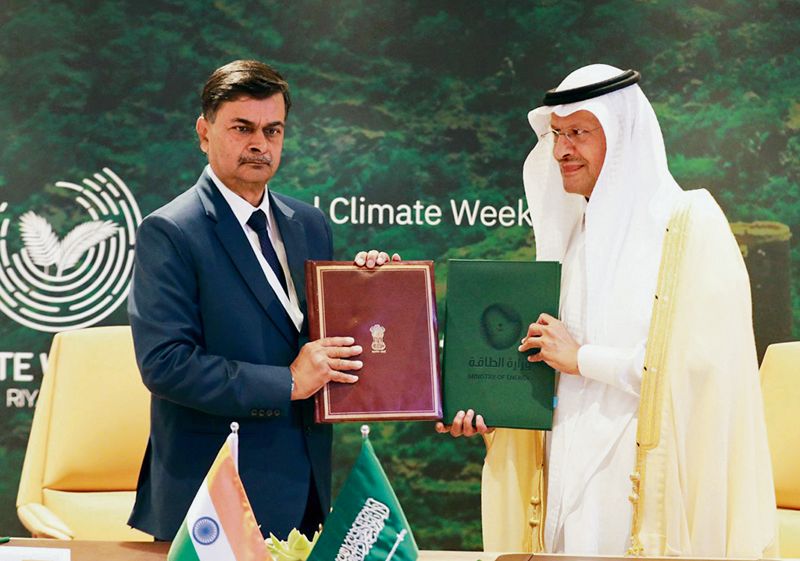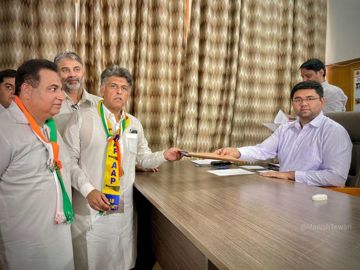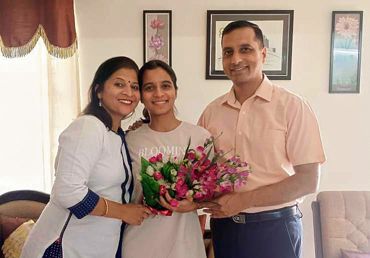
Agreement: India and Saudi Arabia have agreed to deepen their energy alliance by linking power grids. ANI
TK Arun
Senior Journalist
IT is to be hoped that the war Israel is waging against the Hamas would stay confined to the Gaza Strip and not spill over into the wider region. If it does, and Saudi Arabia comes under popular pressure to distance itself from pro-Israeli actions and agents, that would adversely affect some key Indo-Saudi projects, such as the India-Middle East-Europe Economic Corridor and the memorandum of understanding (MoU) on energy cooperation. India’s offer of wholehearted support to Israel, justified in the face of the terror strike by the Hamas but deficient in any expression of sympathy for the Palestinians, who have been suffering for long, could be interpreted by the Arab world as a hostile move and douse Saudi enthusiasm to act on these projects anytime soon.
On October 8, Union Minister for Power RK Singh signed an MoU with his Saudi counterpart; it envisaged interconnecting the grids of the two countries and joint investments in renewable energy, including in the supply chain for the production of green hydrogen.
The ideas in the MoU represent global state-of-the-art power technology. The world at large, and not just India and Saudi Arabia, would benefit from those ideas being converted into reality.
India also hopes to establish grid connectivity with Singapore. Such connectivity is proposed to be established via undersea cables. The implications of such connectivity are radical.
Suppose power generated in Saudi Arabia can be transmitted to India seamlessly via these submarine cables. Submarine cables already use the high-voltage direct current (HVDC) mode to transmit power. The goal would be to move to the ultra HVDC mode of power transmission via these cables. If India and Saudi Arabia manage this feat, it would lay the ground for renewable energy to play a much larger role in the world.
A major problem with renewable power is intermittency; it is not continuous. When the sun does not shine or the wind goes still, power generation would drop. There are multiple solutions to the intermittency problem. One is to deploy grid-level battery storage. This would be very costly. Another is to use the power to pump water up to a height from where it can be brought down later to turn a turbine and generate power. This is called pumped storage. Yet another is to use the power to split water into hydrogen and oxygen, and store the hydrogen and even transport it across large distances. Hydrogen produced using renewable energy is called green hydrogen.
Hydrogen can be stored as gas under high pressure, as liquid at very low temperature or combined with nitrogen to produce ammonia, from which hydrogen can be retrieved later. Ammonia is simpler to store and transport.
But suppose you do not need to store the power at all and simply transport the excess power to a distant location that can consume it directly without needing to store it. That is what would be achieved by combining the national grids of different countries. Suppose, further, that the grid of the renewable energy-generating economy is connected to a power-deficient economy in a different time zone. The time difference between Saudi Arabia and India is two and a half hours. So, when it is 5 pm in India and the brightness of the sun is not enough to generate a whole lot of power, the blazing sun over Saudi Arabia at 2.30 pm could feed demand in India. Typically, power demand goes up and peaks in the evening, and tapers off as the night progresses and most people go to sleep. The time difference between Saudi Arabia and Singapore is five hours. Solar power generated in Saudi Arabia at 3 pm could help meet peak demand at 8 pm in Singapore, if their power grids are connected via India’s.
It is not just the spatial and temporal separation of renewable energy generation from its consumption that would be enabled by interconnecting the grids of India and Saudi Arabia. The undersea cables, with sufficient capacity and buoyed by ultra-heavy voltage direct current transmission technology, would significantly lower the cost of fuelling smokeless cooking in India.
Right now, India relies on liquid petroleum gas (a combination of propane, butane, propylene, butylene and isobutane), filled in heavy steel cylinders, or on methane. While cooking with firewood and other biomass that fill the house with smoke is a major health hazard, particularly for women, giving them cylinders under the Ujjwala scheme is far from the ideal solution.
India has to import crude, from which LPG is made, and natural gas to meet this demand for a clean cooking fuel. This is a major strain on our balance of payments. Ideally, Indians should cook on electricity. If the electricity is produced from locally available coal, we would cook without straining India’s current account deficit, but that would produce a lot of climate-changing greenhouse gases.
If we cook on electricity imported from Saudi Arabia via undersea cables, we would do so while avoiding indoor smoke as well as greenhouse gas emissions, and the strain on the balance of payments would be lower, particularly if large-scale solar generation is resorted to and even if gas, plentiful in the region, has to be burnt to produce the power. Compressing and liquefying gas, filling it in tankers, transporting these to India, and regasifying the liquefied natural gas at the import terminal — all of this adds layers of costs, which can be avoided by the interconnection of grids.
Public health, macroeconomic health and climate mitigation — much is at stake if India and Saudi Arabia translate their energy MoU into functional reality.
Join Whatsapp Channel of The Tribune for latest updates.




























